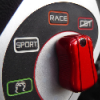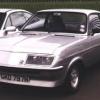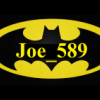F23 internals
Left to Right: 1st Drive Gear, 2nd Drive Gear, 5th Drive Gear, 3rd Drive Gear, 3-4 synchronizer Assm., 4th Drive Gear.

-Facts to remember are 1st, 2nd, and 5th drive gear are cast as part of the input shaft meaning they always turn with the shaft, 3rd and 4th drive gears only drive at the speed of the input shaft when the synchronizer sleeve (which is splined to the input shaft) is locked into either gear.
Next we have the Countershaft.
Top to bottom: Countershaft Final Drive, 2nd gear #1 driven, 2-1 synchronizer Assm., 1st gear #1 Driven

-Facts to remember are, the Countershaft final drive gear is part of the shaft, 1st and 2nd #1 driven gears are only splined to the shaft via the synchronizer being engaged to the gears.
And lastly we have the output shaft.
Left to Right: Final Drive, Rev final driven, R-5 synchronizer Assm., 5th Final Driven, 3rd Final Driven, 4th Final Driven

-Facts to remember are, the Big gear just to the right of the Final drive gear spins freely on the shaft along with the 5th gear final driven until either is selected with the synchronizer sleeve. 3rd final driven and 4th final driven are part of the output shaft and obviously are always engaged with it.
1st Gear: Begins with the first gear from the left on the input shaft. Power is transmitted to the 1st gear #1 driven gear on the countershaft (Big one on the bottom) when the shift fork engages the 1-2 synchronizer into the 1st gear position. The gear is locked to the countershaft and power is transmitted through the shaft to the countershaft final drive which meshes with the second to last gear from the left on the output shaft. From there it turns the final drive gear which of course, turns the differential.
2nd Gear: The shift fork on the countershaft moves back out of first gear position and into second. The second gear from the left on the input shaft drives the 2nd gear from the bottom on the countershaft which is now locked to the countershaft via the synchronizer. Again it drives the Countershaft Final drive gear which meshes with the second to last gear on the output shaft transmiting power through the output shaft to the final drive gear, into the diff.
3rd Gear: Much simpler then 1st, 2nd, or reverse. 3rd is engaged by sliding the 3-4 synchronizer sleeve toward the left locking 3rd drive gear to the input shaft, this transmits power to the second to the last gear on the output shaft which again, is part of the output shaft, turning the differential.
4th Gear: Similar to 3rd the synchronizer sleeve is slid to the right engaging 4th drive gear and locking it to the input shaft. That gear drives the gear furthest to the right on the output shaft which is also part of the output shaft, Driving the output shaft and the differential.
5th Gear: 5th Gear is simple like 3rd and 4th however instead of locking the DRIVE gears to the input shaft they are ALWAYS part of the input shaft which means we have to Lock the DRIVEN gears to the output shaft. In this case the biggest gear (3rd in from left) on the input shaft is the drive gear, again note it is part of the shaft. Its mating member on the output shaft rotates freely until we slide the 5-R synchro towards the right. This locks the 5th Driven gear to the output shaft which turns the Final drive gear.
Reverse: Reverse is unique in this transmission since it uses 1st gear componants. The power flow moves from the first gear on the left of the input shaft, through the largest gear on the countershaft (which spins freely on the countershaft since the synchronizer is not engaged and it rides on the shaft with a roller bearing) This big gear then drives the Large gear 2nd in from left on the output shaft, but since there is an extra step in the gear train the output rotation is reversed. A good way to look at this is that an odd number of meshing gearsets will allow both input and output shafts to rotate the same direction, an even number of gearsets will allow the input and output shafts to rotate in opposite directions.
































